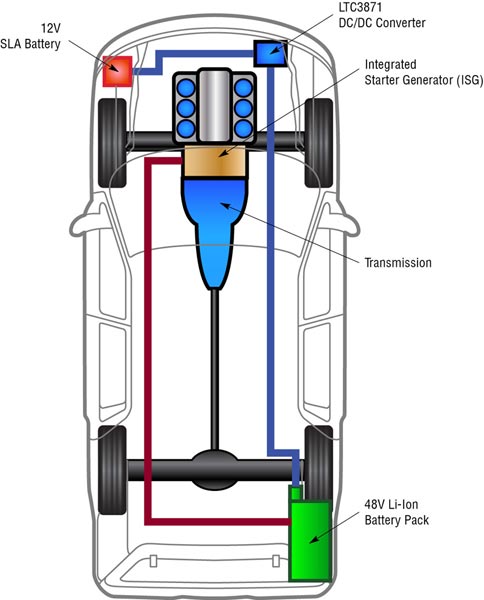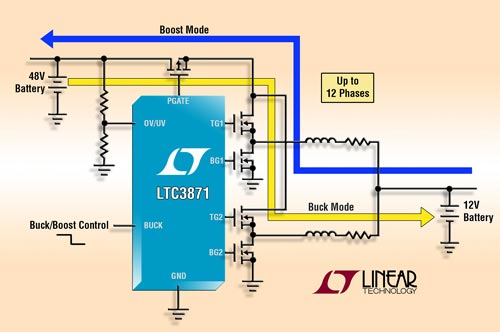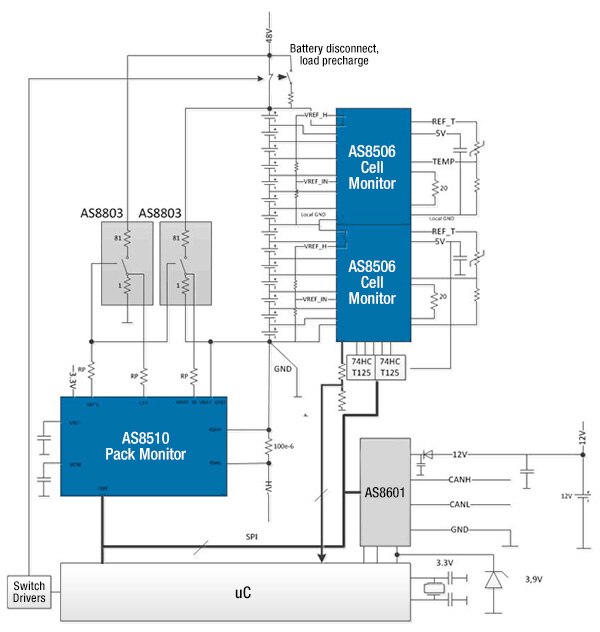Design Considerations for Dual-Voltage Automotive Power Systems
投稿人:DigiKey 北美编辑
2017-02-07
The need for greater efficiency at higher power levels has prompted a move to 48 volt power rails to reduce the current needed when delivering a given amount of power. However, the transition to 48 volt systems is not as simple as installing a bigger battery and generator.
This article will discuss why automobiles need a 48 volt rail and the implications for the full system before introducing a new DC/DC converter that can greatly simplify the design of power systems with dual-voltage (12/48 V) capability. It will then focus on other key 48 volt components and system architectures, including a Battery Management System (BMS) for the new 48 volt Lithium-ion batteries.
Why automobiles need to move to 48 volts
Increasing electrical demands in cars are straining the 12 volt supply. With a 12 volt supply rail, each kW of demand will need about 80 A of current. Also at low temperatures, static-load components can account for the entire power generated by the alternator, up to 3 kW. High currents also translate to higher losses, which run contrary to the need for greater efficiency in order to meet strict year 2020 fuel consumption industry goals, which range from 5.0 to 6.0 L/100 km, depending on location.
To boost efficiency at higher power levels, automotive designers are moving to 48 volt power rails, reducing the current needed when delivering a given amount of power. This higher voltage network enables higher loads (up to 10 kW) to be supported with the same or even narrower cable diameters, reducing cable size and weight. That’s significant because today's high-end vehicles can have more than 4 km of wiring.
In migrating to 48 volts, one configuration a designer should consider is taking the 12 volt electric branch based on a conventional lead-acid battery, and then adding a 48 volt Li-ion battery to power a separate 48 volt branch (Figure 1). This approach is already supported by a number of automotive companies.

Figure 1: The 48 V system features a new Li-ion storage battery. A Linear Technology LTC3871 DC/DC converter integrates both the 12 volt and 48 volt electrical system. (Source: Linear Technology)
For example, the 12 volt system handles traditional loads such as lighting, ignition, infotainment and audio, electric windows, and door locks. The 48 volt system supports heavier loads such as active chassis systems (adjustable suspensions), air conditioning compressors, electric superchargers/turbos, and regenerative braking. The power to start the internal combustion engine (ICE) will be supplied by the Li-ion battery in the 48 volt electrical system, which will make stop/start operations smoother.
The 48 volt technology is targeted at conventional ICE automobiles as well as hybrid electric and mild hybrid vehicles. Mild hybrids use ICEs equipped with an electric motor/generator in a parallel configuration, allowing the engine to be turned off and restarted quickly whenever the car is coasting, braking, or stopped.
Electric supercharging will be used in combination with an integrated starter generator (ISG) which will replace the alternator for the ISG (Figure 1), or a belt-driven starter generator (BSG) will be used. This employs an electric motor to contribute power to the ICE’s crankshaft via a winding belt. The pair should enable automotive manufacturers to increase power by 20%, while at the same time reduce CO2 emissions by 15%, helping to meet stricter emission standards. The European Union’s 2020 standard for cars and vans, for instance, sets a CO2 emission target of 95 g/km across a manufacturer’s car fleet from 2021 onward, with the threat of financial penalties for exceeding these limits.
For the near term, however, the new 48 volt system will operate side-by-side with 12 volt. The 48 volt bus will only supply those functions that need the high-power input and output it provides. A DC-DC converter (Figure 1) will be required to handle bidirectional energy flow at a power level from 300 W to 5 kW, and will allow battery power to be distributed between both voltage domains.
DC/DC converter requirements
The primary function of the DC/DC converter in the dual-voltage system is to transfer energy between the two subsystems. Since it mostly transfers energy from the 48 volt system to the 12 volt level, it is primarily operated as a step-down converter. Situations with converters operating in step-up mode usually only involve partial load requirements to ensure proper 48 volt operation.
At extremely low temperatures, the Li-ion battery may not supply sufficient energy to start the engine, and as a result the 12 volt lead-acid battery can come into play, using a bi-directional DC/DC converter to power the BSG from the 48 volt and 12 volt batteries combined. A typical starter generator can then feed up to 15 kW into the 48 volt system when the ICE is running. The DC/DC converter, in turn, will transfer part of this energy to the 12 volt system to supply its components and charge the lead-acid battery.
Multiple options are possible for the design of a DC/DC converter for 48 volt applications depending upon the requirements. In addition to converter performance, other important requirements include, power loss (efficiency), package space/volume, uni or bidirectional power transfer; and functional safety. The LV148 standard proposed by Audi, BMW, Daimler, Porsche and Volkswagen defines the requirements for a 48 volt power supply system including its functions and interfaces.
The LV148 standard has already been applied in some 2017 models. Any designer considering a 48 volt design should start by referring to this specification. It describes all relevant electrical requirements and test procedures for the new 48 volt components. Note that it also specifies that electrical shock protection is not required for DC voltage < 60 volts, so a high-voltage interlock system (HVIL) is not required. To meet the requirements of LV148, designers can start with Linear Technology’s LTC3871, a 100 V/30 V bidirectional, two-phase synchronous buck or boost controller for 48 V/12 V automotive dual-battery systems.
The LTC3871 operates in buck mode from the 48 volt bus to the 12 volt bus or in boost mode from 12 volts to 48 volts (Figure 2), using the control-signal input to select the mode. Up to 12 phases can be paralleled and clocked out-of-phase to minimize input and output filtering requirements for high-current applications (up to 250 A). Using the 12 phase design, up to 3 kW can be supplied in buck mode or boost mode.
When starting the car, or when additional power is required, the LTC3871 allows both batteries to supply energy simultaneously, and is still capable of up to 97% efficiency.
To regulate the maximum current that can be delivered to the load in either direction, the four on-chip programming loops are used. There are two for current and two for voltage, enabling control of voltage and current on either the 48 volt or 12 volt network.

Figure 2: Multiple LTC3871 chips – up to 12 phases – can be paralleled and clocked out-of-phase to minimize input and output filtering for applications needing up to 250 A. (Source: Linear Technology)
The LTC3871 operates at a selectable fixed frequency between 60 and 460 kHz, and can be synchronized to an external clock over the same range. The designer can select either continuous operation or pulse-skipping during light loads. Additional features include overload and short-circuit protection, independent loop compensation for buck and boost, ±1% voltage regulation accuracy over temperature, as well as under and over-voltage lockout.
Note that like almost any component used for automotive designs, the LTC3871 has been qualified to meet AEC-Q100 automotive specifications.
48 volt battery management
When using the new Li-ion batteries required for 48 volt automotive systems, designers need to opt for a more sophisticated battery management and diagnostic system than is required for a lead-acid battery. Given the safety requirements and many details involved in charging a Li-ion battery correctly, it’s a good idea to look around for a ready-made solution instead of piecing one together from scratch.
Some core requirements a solution needs to address include:
- Measurement of the battery pack voltage, individual cell voltages and current
- Cell balancing
- Separation between the 12 volt and 48 volt domains
- Fail-safe disconnection of the 48 volt domain
ams offers one such solution for the 48 volt automotive power bus (Figure 3).

Figure 3: Rather than designing a battery measurement system (BMS) from scratch, ams offers an off-the-shelf 48 volt BMS based on its AS8510 pack monitor and AS8506 cell monitor. The combination provides accurate cell balancing and low component count while saving development time. (Source: ams)
In the BMS, the measured pack voltage, individual cell voltage, and current data are used to maintain the battery within its safe operating parameters. This is increasingly important because modern cars equipped with an automatic start/stop feature require that the battery’s state of charge (SOC) be maintained at no lower than 50%.
The best way to monitor a Li-ion battery’s SOC is to measure the open-circuit voltage to establish a measurement start point, and then to perform ‘coulomb counting’ – measuring the total current as it exits the battery. This calls for very high accuracy on the voltage channel, and an offset-free current measurement path.
To measure the pack voltage and determine its state of charge, the ams BMS uses the AS8510 data acquisition IC, shown on the left in Figure 3. This battery sensor interface integrates signal conditioning functions and two 16-bit analog-to-digital converters (ADCs). Its accuracy reaches 0.2%.
The same sensor interface also implements coulomb counting, but for this it needs to be paired with a 100 μΩ manganin shunt resistor. The characteristics of the AS8510 are matched to this particular shunt so designers can achieve system-level accuracy of better than 0.5% over the whole automotive temperature range, with a zero offset across the entire measurement range.
Cell balancing
In every battery, there are random variations from one cell to another, which means that some cells become fully charged before other cells do. The goal of battery management is to ensure that all cells maintain an equal state of charge.
The ams AS8506 uses internally synchronized offset-free comparators to make the decision locally about the cells that need to be balanced (Figure 4). Unlike conventional cell-balancing designs, this system doesn’t need a microcontroller.

Figure 4: The ams AS8506 makes cell-balancing decisions locally so the designer doesn’t need to add and program a microcontroller to handle the task (Source: ams)
Other 48 volt system design considerations
With 48 volt Li-ion and 12 volt lead-acid batteries, the input and output voltages will be higher, meaning that higher breakdown voltage components need to be used. Also, due to the higher voltage, corrosion will be a concern. This means switches will require more expensive metals, and spring loaded contacts will have to separate faster to reduce the risk of arcing that could lead to extensive thermal damage. Due to the higher risk of arcing, the 48 volt output to the environment needs to be switched and protected by means of an electronic battery disconnect switch for output control in different vehicle modes.
MOSFETs such as the Infineon Technologies IPB180N10S402ATMA1CT-ND from its OptiMOS line are often used in 48 volt systems as power output-stage ICs. At 48 volts, they outperform IGBTs with respect to switching and conduction losses.
Passive components for 48 volt technology must meet the same high quality standard as components used in 12 volt automotive electrical systems, such as an operating temperature range of - 40 °C to 150 °C, as well as resistance to shock and vibration. In addition, they must also minimize losses so the DC/DC converters can reach efficiency levels of up to 98%.
Conclusion
The introduction of an additional 48 volt level in vehicles will enable drivetrain components such as the oil and water pumps as well as turbo or super chargers to switch from mechanical to electrical power. A 48 volt system also helps reduce CO2 emissions and will help automakers meet tighter fuel economy standards.
However, careful consideration needs to be given to the coexistence of 12 volt and 48 volt power systems, as well as design issues related to the use of Li-ion batteries such as safety, efficiency, and measurement accuracy. For many designers, the best and most expedient option is to use off-the-shelf silicon and system designs from companies such as Linear Technology and ams that have built-in performance and protection features.

免责声明:各个作者和/或论坛参与者在本网站发表的观点、看法和意见不代表 DigiKey 的观点、看法和意见,也不代表 DigiKey 官方政策。









 中国
中国